
- Tabletop games
- Board games
- Tile-based games
- Turn-based games.html
- Abstract strategy games
- card games
- Connection games
- Mancala games
- Paper-and-pencil games
- Word games




A reconstructed Hnefatafl gameboard
|
|
| Years active | 4th-12th centuries |
|---|---|
| Genre(s) | Board game Abstract strategy game |
| Players | 2 |
| Playing time | Typically 5-20 minutes |
| Random chance | None |
| Skill(s) required | Strategy, tactics |
| Synonym(s) | Hnefatafl |
Tafl games are a family of ancient Germanic and Celtic strategy board games played on a checkered or latticed gameboard with two armies of uneven numbers, representing variants of an early Scandinavian board game called tafl or hnefatafl in contemporary literature.
Although the size of the board and the number of pieces varied, all games involved a distinctive 2:1 ratio of pieces, with the lesser side having a king-piece that started in the centre. No complete, unambiguous description of the rules of a tafl game exists, but the king's objective was to escape to (variously) the board's periphery or corners, while the greater force's objective was to capture him. The attacking force has the natural advantage at the start of each game, likely indicating an important cultural aspect by mimicking the success of Viking raids. Another cultural indication of the king is that importance of the Viking chiefs' presence in battle. Although the kings of Europe later claimed divine rule and sat upon the throne rather than bodies in the battlefield, it was essential for a Viking chief to be considered an equal in war. The importance of war is also reflected in Hnefatafl because it is a war strategy game, which can indicate an important reason why the gaming boards have been found with males of all ages. In Balnakeil, a male skeleton between the ages of 8 and 13 was found with weapons and a Hnefatafl board game. Vikings tended to take boys onto the battlefield with them, which explains why young boys also played these war-strategic board games.
There is also some controversy over whether some tafl games (i.e. Hnefatafl and Tawlbwrdd) may have employed dice. Tafl spread everywhere the Vikings traveled, including Iceland, Britain, Ireland, and Lapland. Versions of Tafl, comprising Hnefatafl, Alea Evangelii, Tawlbwrdd (Wales), Brandubh, Ard Ri and Tablut, were played across much of Northern Europe from earlier than 400 B.C. until it was supplanted by chess in the 12th century.
The term tafl (Old Norse: "table", "board"; pronounced ) is the original name of the game. However, Hnefatafl became the preferred term for the game in Scandinavia by the end of the Viking Age, to distinguish it from other board games, such as Skáktafl (chess), Kvatrutafl (Tables) and Halatafl (Fox games), as these became known. The specific name Hnefatafl possibly arose as meaning "board game of the fist", from hnefi ("fist") + tafl, where "fist" referred to the central king-piece. The precise etymology is disputed, but hnefi certainly referred to the king-piece, and several sources refer to Hnefatafl as "King's table". In Anglo-Saxon England, the term tæfl also referred to many board games. It is not known if the Anglo-Saxons had a specific name for the game or if they generically referred to it as "tæfl" in the way that modern people might refer to "cards".
Several games may be confused with tafl games, due to the inclusion of the word "tafl" in their names or other similarities. Halatafl is the Old Norse name for Fox and Geese, a game dating from at least the 14th century. It is still known and played in Europe. Kvatrutafl is the Old Norse name for Tables (the medieval forerunner of Backgammon). Skáktafl is the Old Norse name for Chess. Fidchell or Fithcheall (Modern Irish: Ficheall) was played in Ireland. The Welsh equivalent was Gwyddbwyll and the Breton equivalent Gwezboell; all terms mean "wood-sense". This popular medieval game was played with equal forces on each side and thus was not a tafl variant, but rather may have been the medieval descendant of the Roman game Latrunculi or Ludus latrunculorum.
Hnefatafl was mentioned in several of the medieval sagas, including Orkneyinga saga, Friðþjófs saga, Hervarar saga, and others. These three period treatments of Hnefatafl offer some important clues about the game, while numerous other incidental references to Hnefatafl or Tafl exist in saga literature. Sagas help indicate the widespread use of board games just by mentioning them - although rituals varied in the Viking period from region to region, there were some underlying basics to culture. The fact that the sagas mention board games indicates this use because the sagas are read and understood by a very large audience. In Orkeyinga saga, the notability of Hnefatafl is evident in the nine boasts of Jarl Rögnvald Kali Kolsson, who tops his list with skill at Tafl. In Friðþjófs saga, a conversation over a game of Hnefatafl reveals that the king's men are red and the attackers white, and that the word hnefi does indeed refer to the kingpiece. The most revealing - and yet most ambiguous - clues to Hnefatafl lie in a series of riddles posed by a character identified as Odin in disguise (see Gestumblindi) in Hervarar saga. One riddle, as stated in Hauksbók, refers to "the weaponless maids who fight around their lord, the [brown/red] ever sheltering and the [fair/white] ever attacking him," although there is controversy over whether the word weaponless refers to the maids or, as in other versions, to the king himself, which may support the argument that a "weaponless king" cannot take part in captures (see Balance of play). One may also note that the assignment of the colours of brown or red to the defenders and fair or white to the attackers is consistent with Friðþjófs saga. Another of Gestumblindi's riddles asks, "What is that beast all girded with iron, which kills the flocks? He has eight horns but no head, and runs as he pleases." Here, it is the answer that is controversial, as the response has been variously translated as: "It is the húnn in hnefatafl. He has the name of a bear and runs when he is thrown;" or, "It is the húnn in hnefatafl. He has the name of a bear and escapes when he is attacked." The first problem is in translating the word húnn, which may refer to a die (as suggested by the former translation), the "eight horns" referring to the eight corners of a six-sided die and "the flocks" that he kills referring to the stakes the players lose. Alternatively, húnn may refer to the king, his "eight horns" referring to the eight defenders, which is more consistent with the latter translation, "He has the name of a bear and escapes when he is attacked." Ultimately, the literary references prove inconclusive on the use of dice in Hnefatafl.
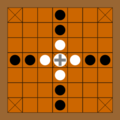 Brandubh
Brandubh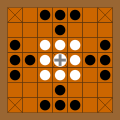 Ard Ri
Ard Ri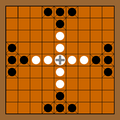 Tablut
Tablut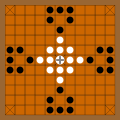 Tawlbwrdd
Tawlbwrdd Hnefatafl
Hnefatafl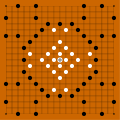 Alea Evangelii
Alea EvangeliiBrandub (Modern Irish: Bran dubh) was the Irish form of tafl. We know from two poems that it was played with five men against eight, and that one of the five was a "Branán", or chief. A number of 7x7 boards have been found, the most famous being the elaborate wooden board found at Ballinderry in 1932, featuring holes for pegged pieces, possibly to allow for portability of the game. The name brandub means "black raven".
Ard Ri (Gaelic: High King) was a Scottish tafl variant played on a 9x9 board with a king and eight defenders against sixteen attackers. This is the least documented of the known tafl variants.
This variant from Sápmi, is the best documented version. Carl Linnaeus recorded the rules and a drawing of the board in his journal during his 1732 expedition to Lapland. His description, in Latin, was incomplete, as he did not speak the Sami language of his hosts and described the game only from observing the players. The game was played on a 9x9 mat of embroidered reindeer hide. In his diary, Lachesis Lapponica, Linnaeus referred to the light (defending) pieces as "Swedes" and the dark (attacking) pieces as "Muscovites". What may have been the same game was still being played in the late 19th century, as described in P.A. Lindholm's Hos Lappbönder (1884).
This variant was played in Wales. It is described as being played with 8 pieces on the king's side and 16 on the attacker's side. Robert ap Ifan documented it with a drawing in a manuscript dated 1587. His version was played on an 11x11 board with 12 pieces on the king's side and 24 on the opponent's side. His passage states:
The above tawlbwrdd should be played with a king in the centre and twelve men in the places next to him, and twenty-four men seek to capture him. These are placed, six in the centre of each side of the board and in the six central positions. And two move the men in the game, and if one [piece] belonging to the king comes between the attackers, he is dead and is thrown out of the game, and the same if one of the attackers comes between two of the king’s men in the same manner. And if the king himself comes between two of the attackers, and if you say ‘Watch your king’ before he moves to that space, and he is unable to escape, you capture him. If the other says ‘I am your liegeman’ and goes between two, there is no harm. If the king can go along the [illegible] line, that side wins the game.
Hnefatafl was a popular game in medieval Scandinavia and was mentioned in several of the Norse Sagas. Some of these saga references have contributed to controversy over the possible use of dice in playing hnefatafl. The rules of the game were never explicitly recorded, and only playing pieces and fragmentary boards are extant, so it is not known for sure how the game was played. If dice were in fact used, nothing has been recorded about how they were employed. Archaeological and literary sources indicate Hnefatafl may have been played on a 13x13 or an 11x11 board. It became a popular game in Northern Europe during the Viking era (end of the 8th century to 1000 C.E), a turbulent time full of conflicts. When chess became a popular game during the Middle Ages, the rules of Hnefatafl were forgotten over time. Hnefatafl was particularly popular in Nordic countries and followed the Viking civilization to other parts of Europe, primarily to the British Isles and the Viking country of "Gardarike." The game developed differently at different locations. Archaeologists have found editions in places such as Ireland and Ukraine. It is thought that the Lewis chessmen were possibly Hnefatafl pieces. Hnefatafl literally translates to "fist table," from the Old Icelandic (equivalently in modern Icelandic) hnef, 'fist', and tafl, 'table'. The study of medieval manuscripts and examination of pieces and boards has allowed researchers to figure out how the game was probably played. It was last recorded to have been played in Wales during 1587 and Lapland in 1723.
Alea evangelii, which means "game of the gospels", was described, with a drawing, in the 12th-century Corpus Christi College, Oxford manuscript 122, from Anglo-Saxon England. It was played on the intersections of a board of 18x18 cells. The manuscript describes the layout of the board as a religious allegory, but it is clear that this was a game based on Hnefatafl.
No complete, unambiguous description of the rules of a tafl game exists. The best description we have from history is that given by Linnaeus of the game Tablut in the 1732 diary of his travels, Lachesis Lapponica. The following rules are based on the 1811 translation of Lachesis Lapponica into English by James Edward Smith.
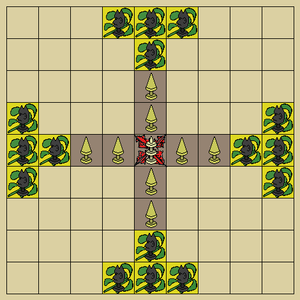 Tablut starting position: lighter "Swedes" start in centre; darker "Muscovites" start at the board's edges. Based on Linnaeus' sketches reproduced in Smith (1811).
Tablut starting position: lighter "Swedes" start in centre; darker "Muscovites" start at the board's edges. Based on Linnaeus' sketches reproduced in Smith (1811).Several problems of gameplay are left woefully ambiguous or completely untouched in Linnaeus' notes, and some translations are problematic. There are also several other variations played by modern reconstructionists. More detailed information on reconstructing the rules of play can be found in this article by Sten Helmfrid.
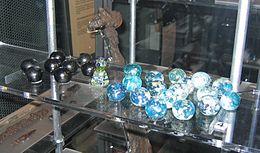 Tafl pieces from Birka in the Swedish Museum of National Antiquities in Stockholm
Tafl pieces from Birka in the Swedish Museum of National Antiquities in StockholmThere is some controversy concerning the widely reported imbalance of the game, as the rules strongly favor the king, although there are several rule modifications that can produce more balanced play, such as a weaponless king (the king cannot participate in captures), escape to the corners (rather than to the edges), or hostile attacker camps (the king and defenders may be captured against a vacant attacker camp square). Schmittberger (1992) even reveals some workarounds to produce more balanced play without modifying the rules of gameplay.
One such solution is by bidding: Players take turns bidding on how many moves it will take them to win the game. The lowest bidder gets the king. Thus, one player may open with a bid of 15 turns, the other player may counter with a bid of 14 turns, and the first player, more confident in his ability to escape in 13 rounds than in his ability to contain for 14, may bid 13 and take the king's side. If that player does not escape within 13 turns, the other player wins. Another workaround is to play a two-round match, in which players switch sides after the first round. If the king escapes both rounds, the winner is the player whose king escaped in the fewest turns.
The description of Tawlbrydd by Robert ap Ifan (preceding Linnaeus' account by 145 years) states that the king could be captured by two men. Peterson suggests that Linnaeus' special capture of the king is incorrect, and states that statistics from modern games played with four-man capture of the king show that white wins more often than black. However, it has not yet been demonstrated that balanced play results from rules allowing for a two-man capture of the king. Interestingly, some sources indicate that Scandinavian museum reconstructions of Hnefatafl typically stipulate that the king may be captured by only two attackers unless he is still in his hall, in which case he must be surrounded on all four sides.
Around 1960, Milton Bradley published Swords and Shields, which was essentially Tablut as recorded by Linnaeus, but with the Swedes transformed into shields (with a king shield) and the Muscovites transformed into swords. Tafl seems also to have been the basis for two other modern board games that each bear significant resemblance to the historical games, but with some important differences. Both games feature similar symmetry but diverge from the classic 2:1 attacker/defender ratio, and both have important differences in their tactics. Breakthru was developed in the 1960s as part of the 3M bookshelf game series. It features tafl-like symmetry, but with twelve defenders plus one "flagship" (cf. king) pitted against twenty attackers upon a tiered board, so that the objective of the defenders is to escort the flagship from the centre to the outer zone of the board. Apart from the distinction of the inner zone and outer zone, there are no distinctive spaces on the Breakthru board. Breakthru also features a distinctive double move, whereas no evidence points to such a move in any of the historical games. Thud, a modern game inspired by a series of fantasy novels by Terry Pratchett (which in turn were inspired by the historical tafl games), also features the general symmetry of tafl games, although it is played on an octagonal board with only eight defenders pitted against thirty-two attackers. Thud also features a "Thudstone" (cf. konakis), but no kingpiece. There are also important differences in the moves and attacks in Thud.
In 2008, Hnefatafl was revived by Peter Kelly in the island of Fetlar in Shetland, where the annual World Quickplay Hnefatafl Championships are now held each summer under the auspices of the Fetlar Hnefatafl Panel. The 2008 Champion was Wendy Sutherland from Yorkshire, while the 2009 and 2010 Championships were won by Tim Millar from Somerset. The term "quickplay" refers to the time limit of ten seconds per move, marked by the sounding of a gong. Hnefatafl can be played online on sites similar to Chess.com. Aage Nielsen created his site in 1998, and currently hosts the World Tafl Federation Hnefatafl Championship Tournament. A modern Hnefatafl game site was launched in 2014, by Jacob Teal and John Carlyle.